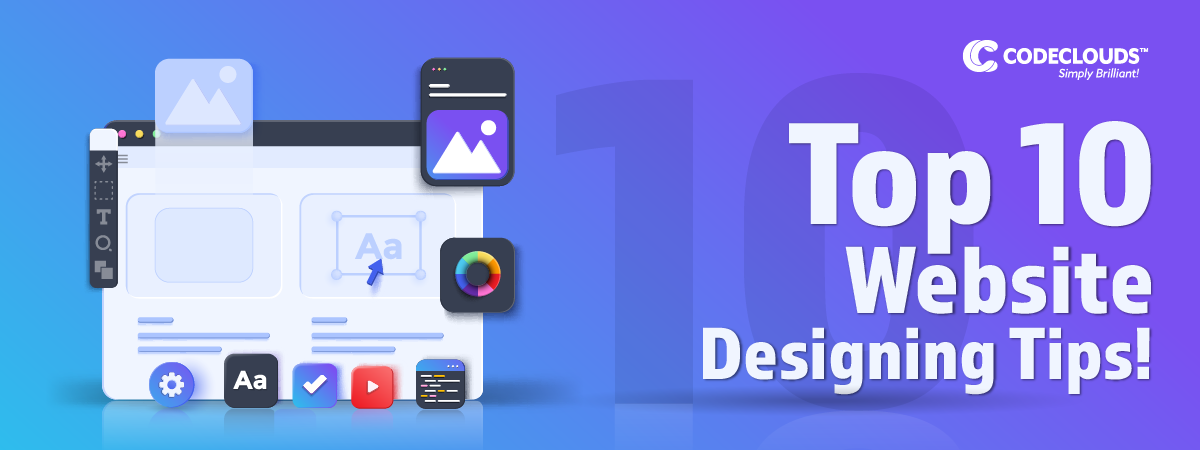Overview
There are many steps in designing a website that can go wrong, affecting visitor retention and overall success. There’s more to making a good website than just the coding. In addition to the latest technical skills, you need to keep up to date with the latest design trends. For an eCommerce website, user experience (UX) is the most important factor. In this article, we’ll check out some good website designing tips to get you started with designing a great website.

Have a Strong, Clear, Brand Message
Project the image you want the world to see. When creating a new eCommerce website, well-designed brand assets are a must—figure out what typography and color scheme will appeal to your customers and stick to it. Try positioning your logo or key message in the top left-hand corner, as this is the part of the screen that our eyes are most naturally drawn to. Implementing these suggestions will not only make your website more aesthetically pleasing but show your customers what your brand is about.
Ensure Your Site Is Easy To Navigate
A site with solid navigation design helps search engines index your content and improves customer experience. The best site structure for this is a flat site structure, one where every page is only a few links away from the homepage. This is great for SEO as it improves your site’s user experience.
Navigation menus and buttons should be easy to identify and use (e.g. not have their own scrollbars), which brings us to…
Make It Accessible
You want to ensure everyone can access your site. This means not just mobile optimization, but also making sure your site works with different browsers and different devices.
In addition, your site should be accessible to disabled visitors. Fortunately, making your site accessible for screen readers is easy, it’s just a case of properly labeling buttons and adding alt-text to images. Using high contrast colors and readable fonts will also make your site more navigable.
Keep It Consistent
Users like to know where they are within a website. If the style of a page changes dramatically or somehow feels different, customers may become disengaged or even lost. They may not realize they’re browsing the same site!
This is as disastrous as it seems—Drastically changing your website weakens your brand persona and may affect your bounce rate (and therefore, SEO). So, maintain consistency by sticking to brand messages and guidelines, and keeping visible design changes to a minimum.
Keep It Simple
Using a website should be quick and easy. There shouldn’t be too much clutter and it should be easy to find the important parts at a glance. Ensure you make use of white space and that readers can scan your website quickly. Use extra features like carousels or pop-ups sparingly (especially on mobile), as they often add little, but worsen user experience.
Remember, not only is clutter a terrible design, but it will make your website load slowly.
Optimize for Mobile
Don’t forget about making your website mobile-friendly. Nearly 55% of worldwide internet traffic is mobile, and mobile traffic will account for 42.9% of eCommerce sales by 2024. So, optimizing your site for mobile is a must.
The bugbear of any mobile shopper, bad mobile optimization has an adverse effect on bounce rates and will drive annoyed customers to your competitors. When optimizing your site for mobile, it is better to use a responsive design rather than adaptive design, so that you don’t split your website’s SERP ranking between 2 or more different pages.
Consider SEO
We’ve mentioned SEO (Search Engine Optimization) before—and we’ll mention it again because it’s really important. As we’ve discussed, many aspects of website design—mobile optimization, site structure, and general UX, can have a positive or negative impact on your rankings. Other SEO factors to consider include loading speed and quality of content (e.g. does your website have videos and a blog?).
It doesn’t matter how aesthetic your design is if your website is languishing on page 3 of the SERPs (Search Engine Results Pages).
Include Social Share and Follow Buttons
Producing a great looking website with great content only goes so far if you aren’t offering your users the opportunity to share what you have. If your website has no social share buttons or links to your social media, you could be missing out on a lot of social media traffic that’s generated from people already browsing your website.
Use Images Wisely
Optimizing your images can significantly contribute to improving your search rankings, increasing your leads and generating traffic. Pictures not only make your site more attractive but also increase the visual experience as customers view your products.
Make sure you avoid stock photos though—it’s better to use high-quality original images. Large images can affect your SEO, but, for the best user experience, you should aim to compress them instead of using low-quality images.

Test Your Designs
Before going public with your website, test it thoroughly on different browsers and devices to ensure it works effectively for all potential users. A beta site is great for this, and for trying out any future updates without harming your SEO before adding them to your live site. Consider using A/B testing, and remember you’ll have to keep on testing your website regularly to make sure it’s working properly.
If you still need help with designing your business website, consider hiring our design experts.
Share this article
455 reads
Similar Reads








